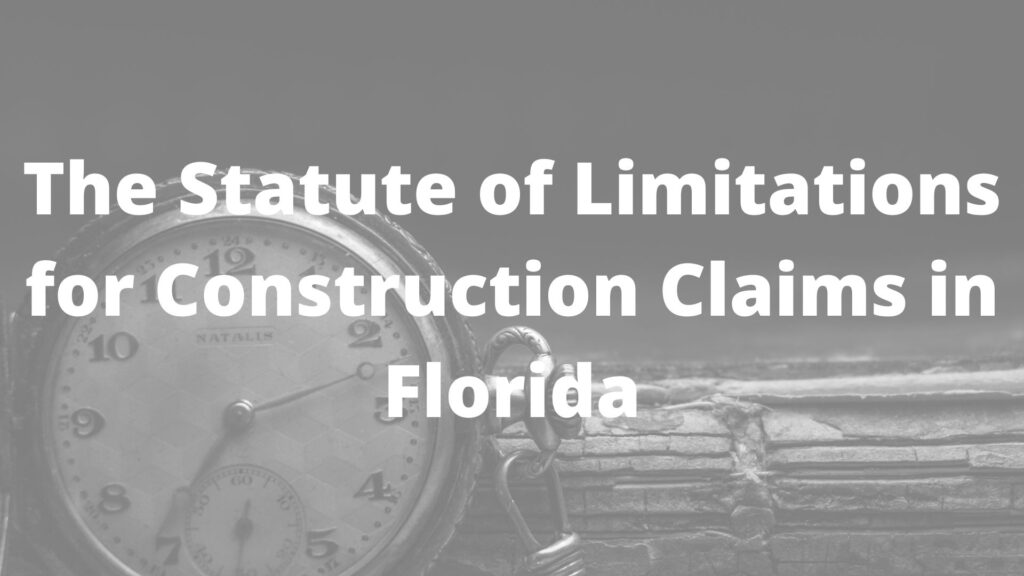
Construction projects, no matter how well-planned, can sometimes lead to disputes. Whether it’s a defect in workmanship, a breach of contract, or an issue with design, understanding the time limits for filing a lawsuit is crucial for protecting your rights in Florida. These time limits, known as statutes of limitations and statutes of repose, dictate how long you have to bring a claim. Missing these deadlines can result in your claim being permanently barred, regardless of its merits. Let’s break down the key deadlines for various construction-related claims in the Sunshine State.
Construction Defects: The 4-Year Statute of Limitations and 7-Year Statute of Repose
Florida law provides specific timeframes for claims arising from construction defects. These are often the most complex and frequently litigated claims.
Statute of Limitations (4 Years): Generally, a lawsuit for a construction defect must be filed within four years from the time the defect is discovered or should have been discovered with the exercise of due diligence. This “discovery rule” means the clock doesn’t necessarily start ticking on the day the work is completed if the defect is hidden (latent). However, for practical purposes, the clock often starts running from the earliest of several events, including:
- Issuance of a temporary or permanent certificate of occupancy.
- Completion of the building.
- Abandonment of construction (if not completed).
- Statute of Repose (7 Years): This is a critical absolute deadline. Regardless of when a defect is discovered, a lawsuit for a construction defect cannot be brought more than seven years after the earliest of the following:
- Issuance of a temporary or permanent certificate of occupancy.
- Issuance of a certificate of completion.
- Date of abandonment of construction if not completed.
Important Recent Change: Florida’s Statute of Repose for construction defect claims was recently reduced from ten years to seven years. This is a significant change that shortens the period of potential liability for contractors and the timeframe for property owners to identify and file claims. For claims that would not have been time-barred under the old 10-year period, plaintiffs had until July 1, 2024, to file.
Pre-Suit Notice Requirement (Chapter 558): Before filing a lawsuit for construction defects, property owners in Florida are generally required to provide written notice of the alleged defects to the contractor, subcontractor, supplier, or design professional at least 60 days prior to commencing the lawsuit. This “right to cure” process allows the responsible party an opportunity to inspect the defects, offer a settlement, or make repairs, potentially avoiding litigation.
Breach of Contract Claims
Construction projects are built upon contracts. If one party fails to uphold their obligations under a contract, a breach of contract claim may arise.
- Written Contracts (5 Years): For claims based on a written construction contract, the statute of limitations in Florida is generally five years from the date of the breach.
- Oral Contracts (4 Years): If the construction agreement was an oral contract, the statute of limitations is four years from the date of the breach.
Professional Negligence (Architects and Engineers)
Claims against architects, engineers, and other design professionals for negligence related to construction projects have their own specific deadlines.
- Four-Year Statute of Limitations: Florida courts have clarified that construction-based professional malpractice claims against design professionals are generally subject to a four-year statute of limitations. This period typically begins when the cause of action is discovered or should have been discovered with due diligence.
Construction Liens
Construction liens (also known as mechanic’s liens) are legal claims against a property to secure payment for labor, services, or materials provided for its improvement.
- Filing the Claim of Lien (90 Days): A claim of lien must be recorded within 90 days from the date the lienor last furnished labor or materials to the project.
- Enforcing the Lien (1 Year): Once a valid claim of lien is recorded, the lienholder has one year from the date of recording to file a lawsuit to foreclose on the lien. Failure to do so within this timeframe will result in the lien expiring.
- Notice of Contest of Lien: If a property owner files a “Notice of Contest of Lien,” it significantly shortens the time for the lienholder to enforce their lien from one year to just 60 days from the date the notice is served on the lienor.
John Caravella Esq., is a construction attorney and formerly practicing project architect at The Law Office of John Caravella, P.C., representing architects, engineers, contractors, subcontractors, and owners in all phases of contract preparation, litigation, and arbitration across New York and Florida. He also serves as an arbitrator to the American Arbitration Association Construction Industry Panel. Mr. Caravella can be reached by email: [email protected] or (631) 608-1346.
The information provided on this website does not, and is not intended to, constitute legal advice; instead, all information, content, and materials available on this site are for general informational purposes only. Readers of this website should contact their attorney to obtain advice with respect to any particular legal matter. No reader, user, or browser of this site should act or refrain from acting on the basis of information on this site without first seeking legal advice from counsel in the relevant jurisdiction. Only your individual attorney can provide assurances that the information contained herein – and your interpretation of it – is applicable or appropriate to your particular situation. Use of, and access to, this website or any of the links or resources contained within the site do not create an attorney-client relationship between the reader, user, or browser and website authors, contributors, contributing law firms, or committee members and their respective employers.

